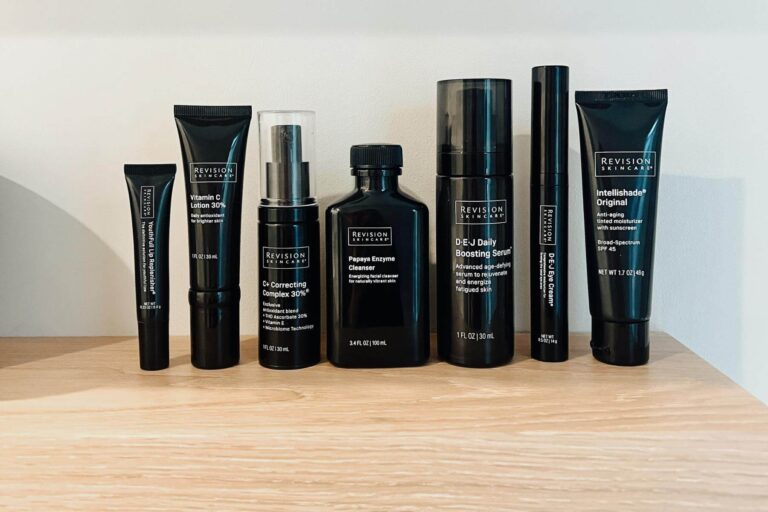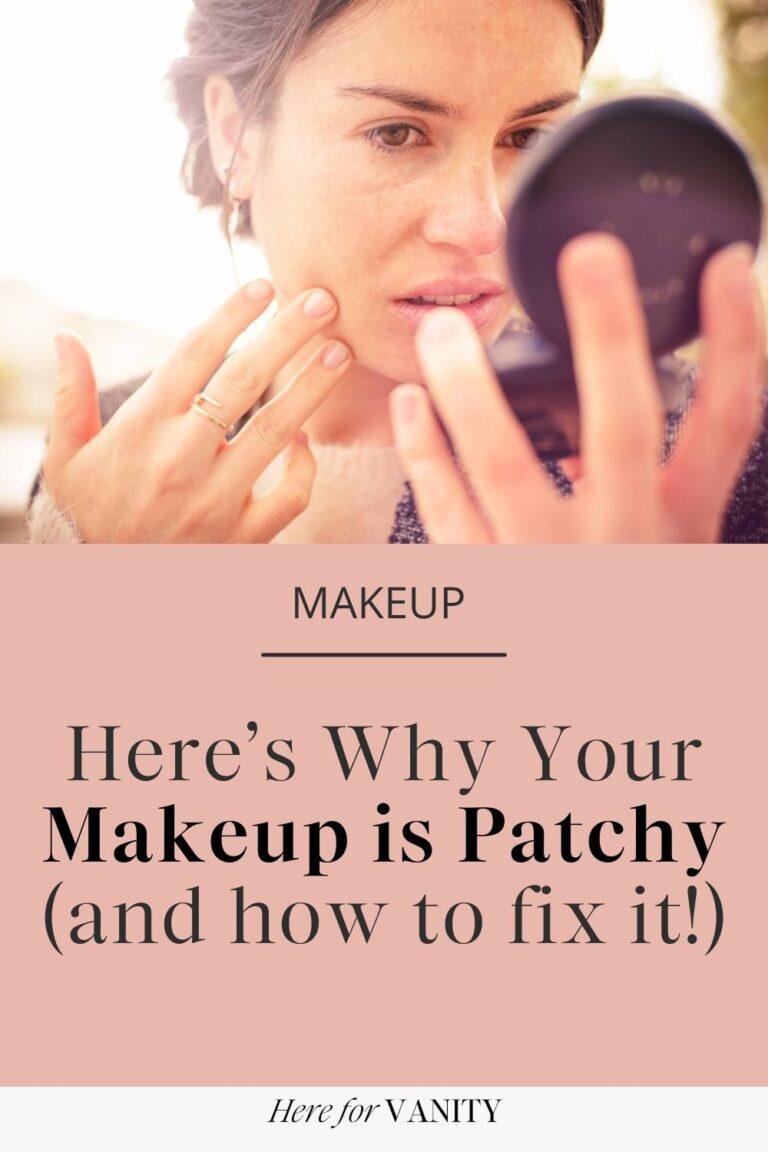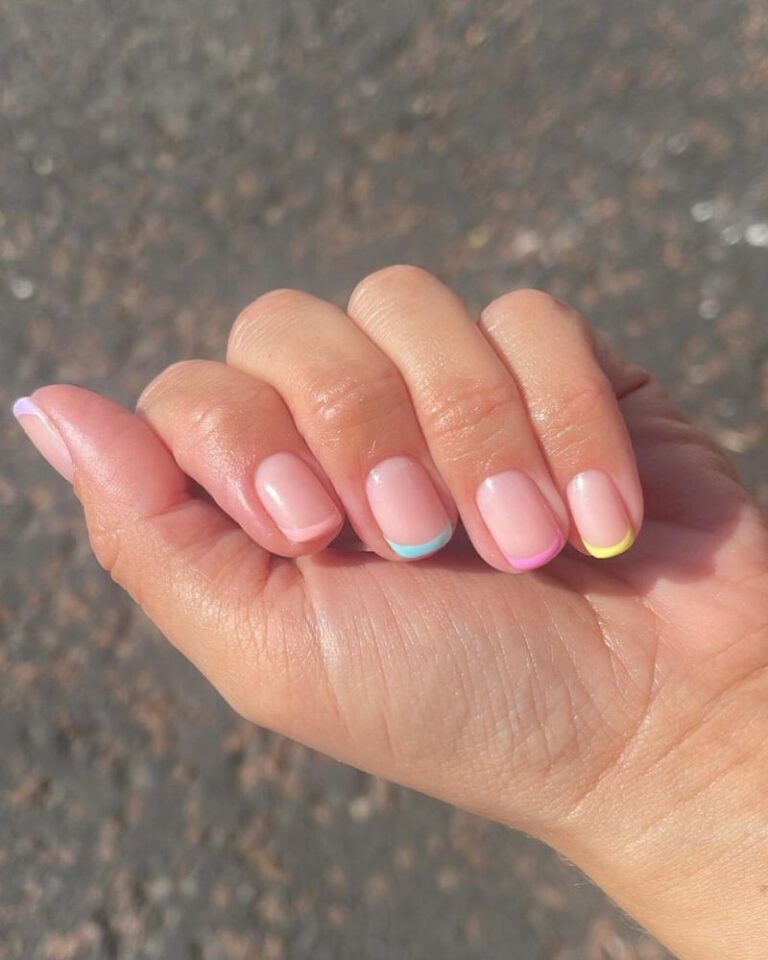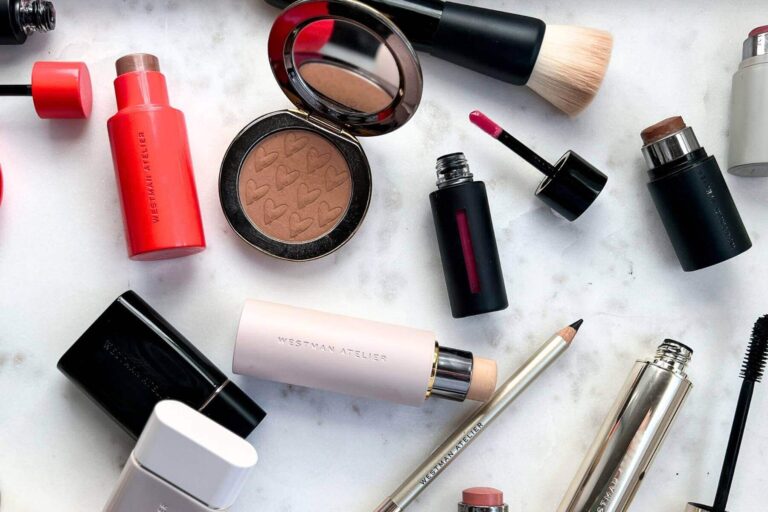My Sculptra Before and After Photos: The Best Glow Up
Curious about Sculptra? Here’s my experience and my Sculptra before and after results! All photos are of me without any editing.
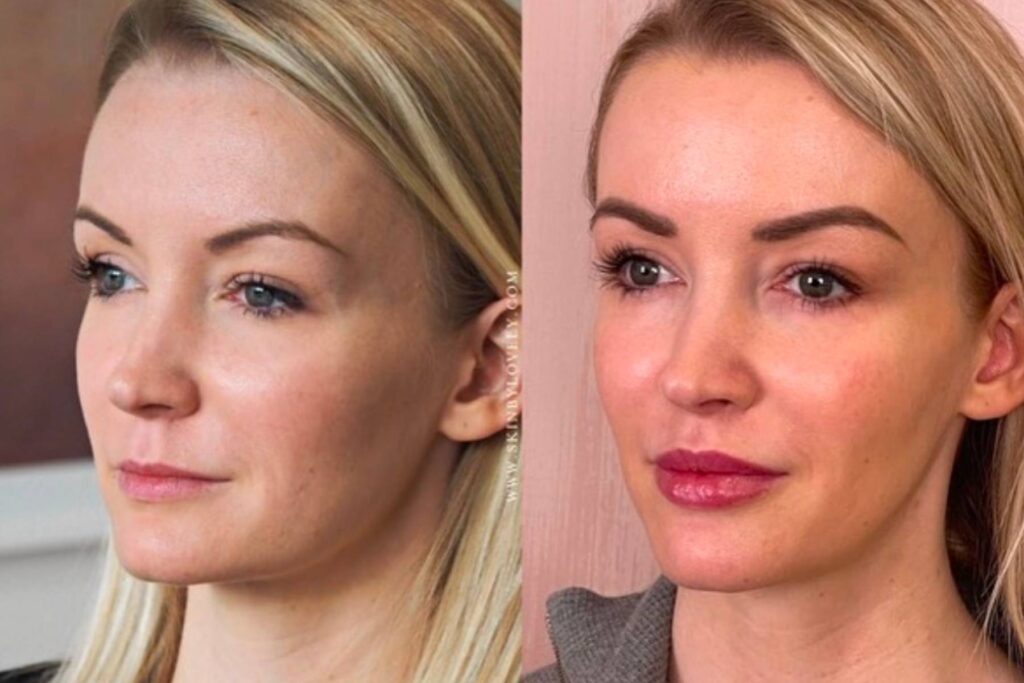
Aging hits differently as you approach 40. One day, you’re just minding your business, and the next, you catch a glimpse of yourself in bad lighting and realize your face looks…tired. Not wrinkled, not sagging—just deflated.
That was me.
I’m not against traditional fillers, but there has been so much controversy around fillers turning in your face forever. And I didn’t want that overfilled, pillow-face look. So when my aesthetician suggested Sculptra as a way to restore lost volume naturally, I was intrigued.
Here’s my honest experience, including my Sculptra before and after results.
Why I Chose Sculptra Over Traditional Fillers
Continue reading for my personal experience with Sculptra and my Sculptra before and after photos!
Aging isn’t just about wrinkles—sometimes, it’s about looking like you haven’t slept in five years, even when you have. That was my reality as I inched toward 40.
My skin still looked good, but my face had lost that natural fullness that made me look fresh and rested. My cheeks looked flatter, my temples a little hollow, and overall, I just looked…tired.
I knew filler could replace lost volume, but I also knew I didn’t want that overfilled, “puffy” look that happens when too much hyaluronic acid (HA) filler is used. I wanted to look like me, just slightly better.
That’s when my aesthetician suggested Sculptra, explaining that it wasn’t a typical filler but a collagen-stimulating injectable that would gradually help my face rebuild volume.
There is no instant plumping or obvious changes overnight—just a slow, natural-looking refresh. That sounded a lot more appealing than chasing volume with HA fillers every six months, so I decided to give it a shot.
What Is Sculptra? How It Works vs. Hyaluronic Acid Fillers
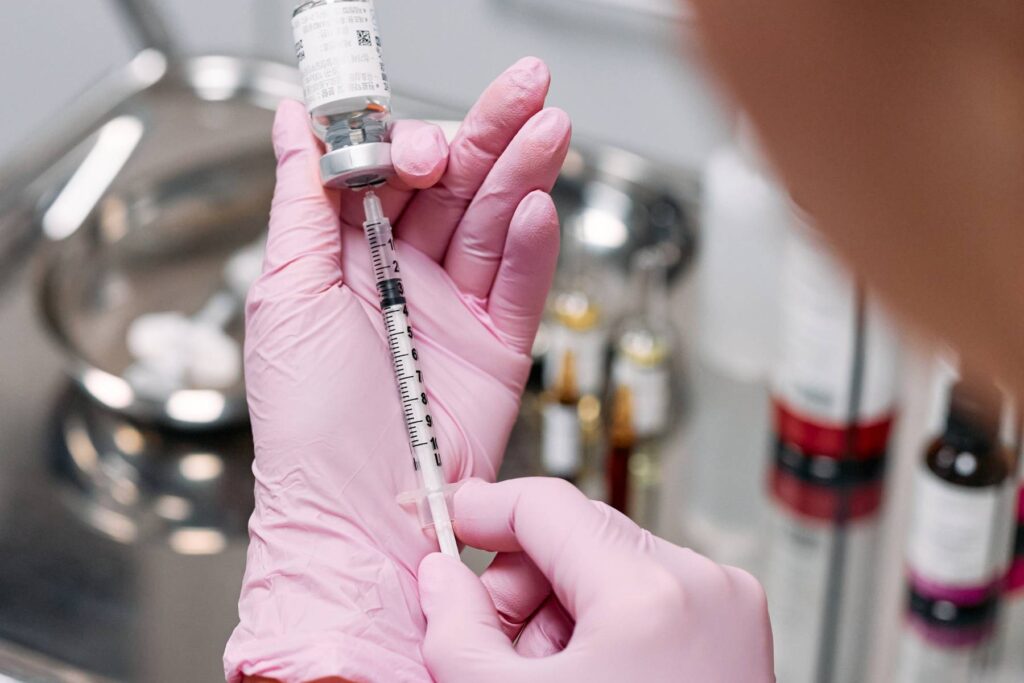
Most people hear “injectable” and assume it’s just another filler, but Sculptra isn’t a filler—it’s a biostimulator. Instead of just adding volume like hyaluronic acid (HA) fillers do, Sculptra actually triggers your skin to produce its own collagen over time.
Here’s the difference:
HA fillers (like Juvederm and Restylane) provide instant volume by physically filling in areas with gel. They’re great for quick fixes but require regular maintenance as they dissolve within 6–12 months.
Sculptra is made of poly-L-lactic acid (PLLA), which doesn’t fill—it stimulates your body to rebuild lost collagen. The process takes months, but the results last up to two years or more.
This is why Sculptra is perfect for restoring natural volume rather than just “adding” it. It’s more of a long-term investment in your skin rather than a quick fix, which is exactly what I wanted.
The Benefits of Sculptra: Why It’s Worth Considering
Once I wrapped my head around the fact that Sculptra isn’t a filler, I started getting excited about what it could do. Unlike traditional fillers that just sit under the skin, Sculptra works with your body to restore natural volume over time.
Here’s why I went for it and why I continue to get a Sculptra touch-up every year or so:
- It looks incredibly natural: No puffiness, no “done” look—just a gradual, subtle plumpness that made me look refreshed, not altered.
- The results last: While HA fillers break down within a year, Sculptra stimulates your own collagen, which sticks around for up to two years or more.
- It improves skin quality: Beyond volume, Sculptra helps with skin texture, firmness, and elasticity, giving that healthy, youthful bounce back.
- No maintenance every few months: With fillers, you’re constantly topping up to maintain results. Sculptra is gradual, but long-lasting since it builds more collagen over time.
- The biggest selling point? I still looked like myself, just…better. My face didn’t change overnight, but as the months passed, I noticed that my skin looked fuller, smoother, and happier.
The Risks and Downsides of Sculptra
Honestly, I was a little apprehensive about Sculptra at first. My go-to research site, RealSelf, had it sitting at around a 75% “Worth It” rating when I first looked into it. That’s not exactly glowing.
While overall positive, some people noted lumpiness, granulomas, and the fact that unlike filler, Sculptra can’t just be dissolved if something goes wrong.
Naturally, I brought this up with my provider. She told me that the risk of nodules (small lumps under the skin) was low if the injector knew what they were doing and if I followed the aftercare instructions. That meant religiously massaging the treated areas five times a day for five minutes, for five days. And let me tell you, that part was annoying. The last thing I wanted to do was interrupt my day to massage my face, but skipping it increases the risk of uneven results.
Other things to keep in mind:
- No instant gratification: Unlike fillers, Sculptra takes months to kick in. If you want immediate volume, this isn’t for you. I did have some initial swelling from the solution, but that went away after a day or so.
- Results can be unpredictable: Because it relies on your own collagen production, no two people get the same outcome. Some need extra sessions, while others see a dramatic difference with just one or two.
- It requires upkeep and a few Sculptra vials to start. My provider followed the general rule of one vial per decade of age, so at almost 40, I needed four initial vials and then about a vial (session) each year to maintain.
Another hesitation I had was realizing that Sculptra works by triggering collagen production through controlled inflammation. Essentially, it stimulates your skin by causing a mild form of injury. That made me wonder: Would this make a future facelift more complicated? Because I fully plan on getting one at some point.
When I asked a plastic surgeon about it, he assured me it wasn’t a major concern. While surgeons do notice firmer, slightly denser skin in patients who’ve had Sculptra, it doesn’t make a facelift more difficult or lead to complications.
He explained that they’re used to working with it, and it wouldn’t prevent me from getting the results I want down the line.
Final Thoughts: Is Sculptra Worth It?
For me, 100% yes, but only if you go into it with the right expectations.
Sculptra isn’t a quick fix, and it’s not for anyone wanting instant volume. It’s a slow burn, and the waiting period can mess with your head. But it’s hard to beat if you’re looking for natural, long-lasting results that build gradually. Also, it is not as dramatic as fillers and results can be unpredictable.
You might find that alternating Sculptra with your favorite hyaluronic acid filler is the right way. I think I did this with my temples, actually – the Sculptra didn’t fully fill that area out, and we had to go in with a little filler about 6 months later.
Would I do it again? Absolutely. It gave me a good glow to the skin and subtle volume without looking overfilled. And the fact that it lasts for years makes it feel like a smarter investment than constantly refilling HA fillers.
Who Should Consider Sculptra?
✅ If you want gradual, natural-looking volume restoration
✅ If you’re okay waiting months to see full results
✅ You want something that is long-term and gradual
✅ You’re not a fan of the “filler look”
Who Might Not Love Sculptra?
❌ If you want instant results—Sculptra takes time
❌ If you can’t commit to the massage routine (seriously, don’t skip it)
❌ You’re worried about not being able to dissolve it like HA fillers
At the end of the day, Sculptra isn’t for everyone, but for me, it was the perfect option. It gave me back the volume I had lost without making me look like I “had work done”—and honestly, that’s all I wanted.
My Sculptra Before and After Photos
Here are my Sculptra “before and after” photos. I also do Botox and lip filler. The top two photos are approx 1-2 years apart. My below photos also reflect porcelain veneers before and after.

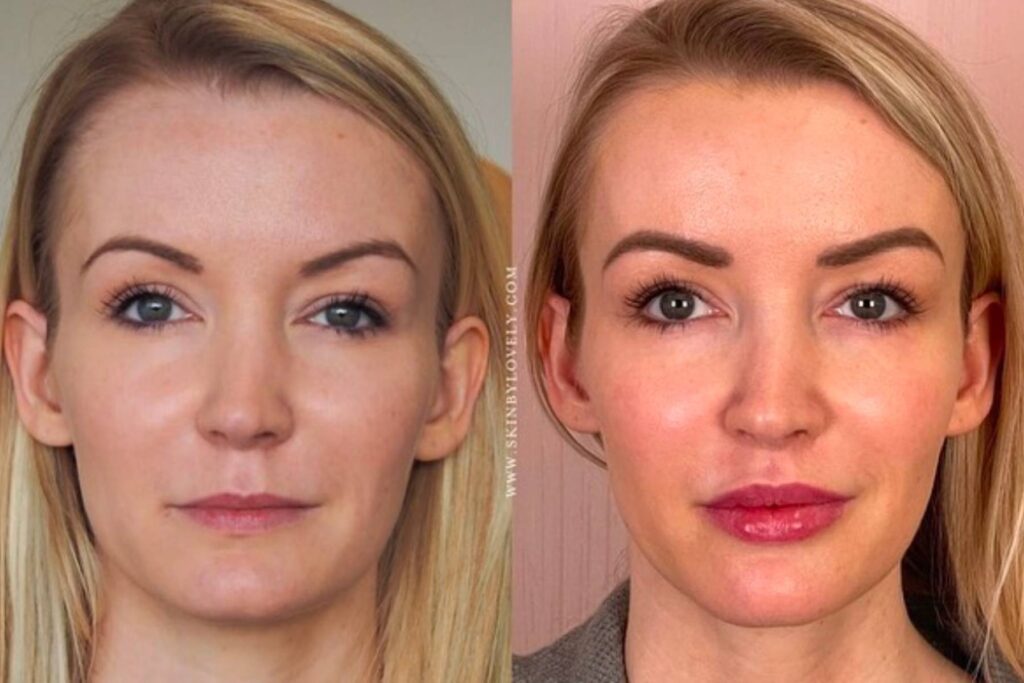
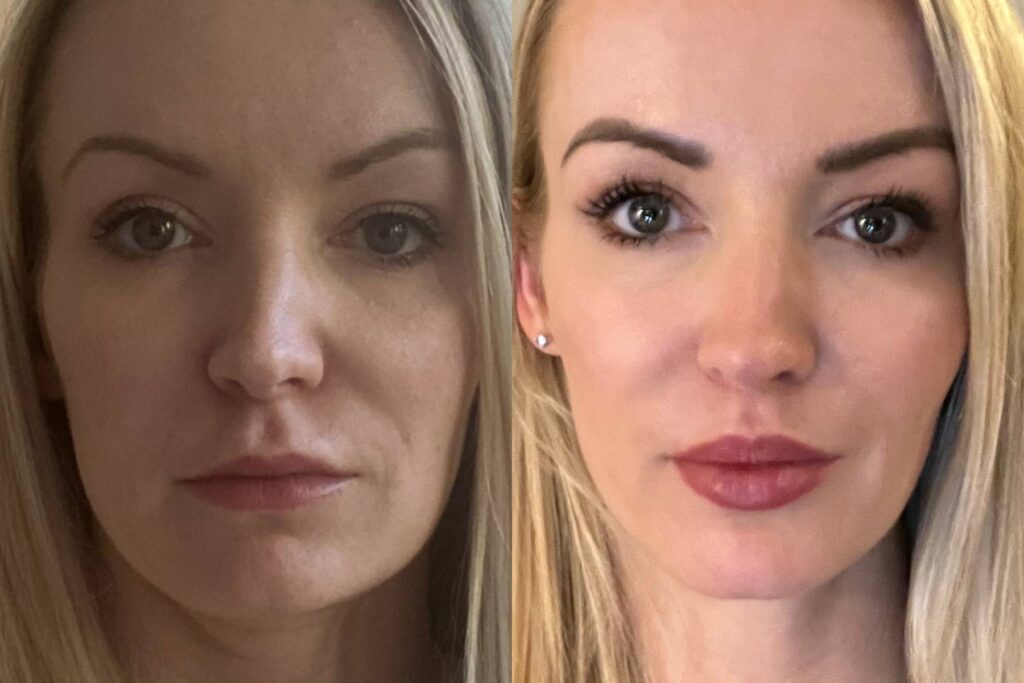
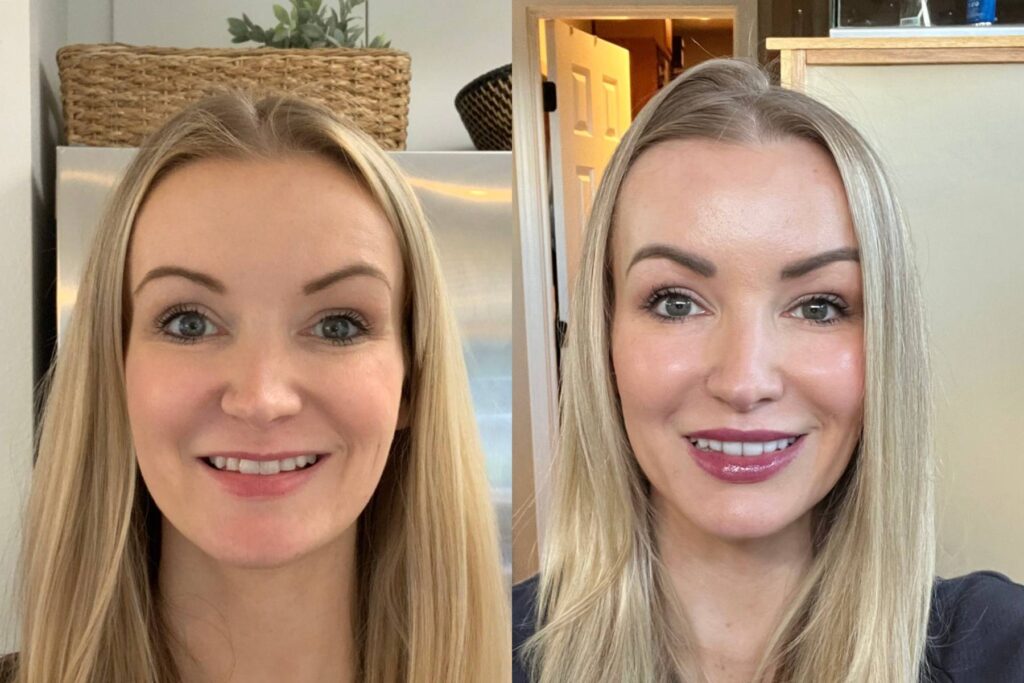
Related: My Lip Lift + Veneers: Before and After Transformation
Common Sculptra FAQs I Get
Over time, I’ve had plenty of people ask me about my Sculptra experience, especially once they see how natural the results look. Here are some of the most common questions—and my honest answers.
1. Does Sculptra hurt?
Not really! My injector used a cannula instead of a traditional needle, which made the process feel more like pressure and weird movement under the skin rather than actual pain. That said, if you get your temples done—with Sculptra, filler, or anything else—expect some soreness later. It’s not the injections themselves that hurt, but a deep, dull ache that settles in your jaw and side of the head for a couple of days. Not unbearable, but definitely noticeable.
2. How much did Sculptra cost?
Pricing varies, but in my case, I paid $850–$1,000 per vial. And remember that general rule—one vial per decade of age—so at almost 40, I started with a little under that (3 vials spread over a few sessions). Now, for maintenance, I do one to two vials per year to keep my results. It’s not cheap, but considering how long it lasts, it’s a better value than constantly refilling HA fillers.
3. How long does Sculptra last?
Once your collagen builds up, Sculptra can last over two years—sometimes longer. Unlike fillers that dissolve, Sculptra works by stimulating your body’s own collagen, so the results stick around as long as your skin holds onto that new structure. That’s why maintenance is usually just one or two vials a year, instead of starting from scratch every time.
Tip: My provider said taking a collagen supplement improves Sculptra results. I couldn’t find any study that backs this up, but I still take powdered collagen with my protein smoothies every day to help support.
4. Can Sculptra be dissolved if I don’t like it?
Nope. Unlike hyaluronic acid fillers, which can be dissolved with hyaluronidase, Sculptra is permanent in the sense that you have to wait for your body to break it down naturally. This is why finding an experienced injector is non-negotiable—placement is everything, and you don’t want to risk lumps or uneven results.
5. How soon will I see results?
Not immediately. Sculptra works slowly, and most people don’t start seeing noticeable changes until six to eight weeks in. Full results can take three to six months, so patience is key. It’s not like fillers where you walk out of the office looking instantly refreshed—this is a long game.
My injector did say that you’ll start to see the ” Sculptra glow” sooner than the filling results meaning you’ll see some improvement in the skin quality.
6. Can I still get other treatments with Sculptra?
Yes! I still get Botox without any issues and am able to do them in the same session too.
7. Where can Sculptra be injected?
Sculptra works best in areas that need gradual, natural volume restoration, like the cheeks, smile lines, temples, and jawline. It’s great for filling in hollows and subtly lifting the face over time.
However, it’s not recommended for under the eyes or lips. The skin under the eyes is too thin, making it more prone to lumps and unevenness, while the lips need a softer, more precise filler—Sculptra can feel too firm and unpredictable there.
If you’re looking to refresh your midface and restore lost volume without looking overfilled, Sculptra is a solid option. It may take multiple treatments and / or in combination with filler as well. My temples, for example didn’t fill out completely. I added a touch of filler later on to help.
For more honest beauty insights, skincare tips, and all things glowing up after 40, follow me on Pinterest and Instagram!

